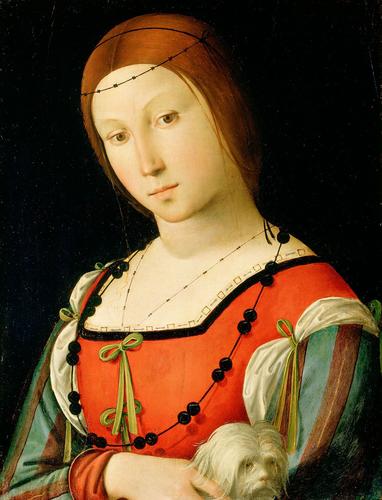-
1 of 253523 objects
Portrait of a Lady with a Lapdog c. 1500-5
Oil on poplar panel | 45.4 x 35.0 cm (support, canvas/panel/stretcher external) | RCIN 405762
-
The sitter’s costume, with detachable sleeves decorated with stripes and a band around the crown of her head, is typical of north Italian court fashion 1490-1505. The identity of the sitter is uncertain, but she was most probably a member of the Bolognese or Mantuan courts. One suggestion is that this portrait depicts Isabella d’Este (1474-1539). In 1508 Isabella sent two portraits by Lorenzo Costa, one of herself and one of her daughter, Eleonora, to her husband, Francesco Gonzaga, who was being held captive in Venice. An unattributed portrait of Isabella, thought to be by Costa and probably a version, was given to the English ambassador in 1514, although it does not appear in any subsequent Royal Collection inventories (the present work was not recorded until the reign of Charles II). Isabella was a famous dog-lover and it has been suggested that the dog here is an allegory of fidelity, echoing the motto in Isabella’s studiolo, ‘bona fé non est mutabile’ (‘Good faith is unchanging’). There is a version of this portrait in the Sterbini collection, Rome, and an autograph variant in the Currier Museum of Art, Manchester, New Hampshire.
The sitter is however probably too young for Isabella, who was thirty in 1504. It is possible that it could portray her daughter Eleonora, born in 1493. According to a letter, Costa was painting Eleonora in 1508. The Gonzaga and Bentivoglio families were closely related by marriage. It may be that it depicts one of the other young heiresses of the Bolognese or Mantuan courts that have been proposed as candidates. Although her identity is uncertain, the charming elegance of the portrait captures the refined sophistication of the north Italian courts at this date.
The sitter’s dress in this portrait is typical of the fashion of north Italian courts (Milan, Mantua and Ferrara) during the two decades 1490 to 1510: detachable sleeves, decorated with stripes, are tied to a red dress; her white shift is visible at these joins and at the neck, where it has a finely detailed border. The band around the crown of her head is called a ‘lenza’ and sometimes holds a jewel. She also wears a necklace which falls on her chest. Her hair is pulled back from her face and may be wrapped with a covering (coazzone) intended to hold it in place.
The fine linear style here can be compared with Costa’s work before his move to Mantua in 1507. The girl’s idealised features in the present portrait appear in his sacred and secular works dated 1505-6. The elegant tilt of her head is close to that of Costa’s Venus of c.1505-6 (private collection), and his drawing of the Allegory of Fortune (Kupferstickabinett, Berlin). The way in which the girl holds her dog is strongly reminiscent of Cecilia Gallerani’s elegant pose caressing an ermine in Leonardo’s famous portrait of c.1490 (Czartoryski Museum, Cracow), which Isabella borrowed in 1498 for comparison with portraits by Giovanni Bellini.
Costa’s fine technique and the use of the dark background show the influence of the Netherlandish paintings he would have been able to study at the Este court at Ferrara. The ground has an underlayer of green and pink for the skin, through which some of the many fine drawing lines for outlines and features are now discernible. There is no evidence that this portrait formed the right hand half of a diptych, as has been suggested.
Catalogue entry adapted from The Art of Italy in the Royal Collection: Renaissance and Baroque, London, 2007Provenance
First recorded in the Store at Whitehall in 1666 (no 516)
-
Creator(s)
Previously attributed to (artist)Acquirer(s)
-
Medium and techniques
Oil on poplar panel
Measurements
45.4 x 35.0 cm (support, canvas/panel/stretcher external)
63.6 x 52.5 x 6.7 cm (frame, external)
Category
Object type(s)
Other number(s)
Alternative title(s)
Eleonora Gonzaga (1598-1665), previously identified as
Isabelle d'Este, previously identified as

